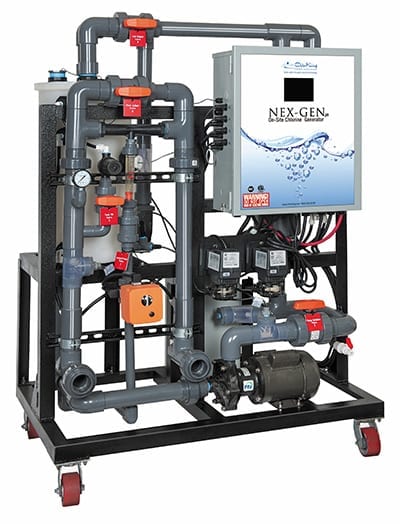
ChlorKing Cites Water and TDS Management as Key Factors in Onsite Chlorine Generation
Norcross, GA Oct. 16, 2018 – For anyone involved in specifying and approving a new onsite chlorine generation system, initial cost is just one factor, according to officials at ChlorKing, the world’s leading designer and manufacturer of on-site chlorine generation for commercial pools.
“Key factors include water use and TDS levels, and the factor that affects a pool owner most depends on where the pool is located,” said Steve Pearce, Executive Vice President, ChlorKing. “If a pool is located in an area that’s greatly affected by drought conditions or high water costs, you need a system that can use pool water as the primary water source instead of continually adding fresh water. If your pool is in an area plagued by hard water or if high levels of TDS (total dissolved solids) are a concern, you need to reduce the amount of salt you add to the chlorine-generation process.
“You can’t just look at the lowest cost of equipment,” he continued. “You need to be smart about the technology your system uses and how it will help you comply with various restrictions imposed by regulations or market needs. And, you also need to look at total operating costs over the lifetime of your chlorine generation system. When you do that, ChlorKing’s NEXGENpH chlorine generations are the clean winner.”
Calling reduced water use one of the most critical factors in generating chlorine, Pearce points out that NEXGEN’s patented technology drives the only batch chlorine generation system that can use pool water as the water source. All other batch chlorine technologies require the addition of fresh water to the onsite generator, and that adds to both water consumption and to storm-sewer use, which creates an additional cost.
ChlorKing’s technology uses an automated system to measure TDS already in the pool water and uses that TDS before adding additional salt required to generate chlorine.
“Other systems add a lot more TDS to pool water because they require 3 pounds of salt for every pound of chlorine they produce,” Pearce said. “Those systems work against pool owners who face high TDS levels or want to maintain lower TDS in their pools. It’s advisable not to use those technologies with regenerative media filters because of the rapid increase of TDS with no backwashing and water dilution. NEXGEN is the ideal solution because the technology can automate maximum TDS levels as required by the operator.
“Finally,” he added, “we focus on swimming pool sanitization, and we concentrate on refining our patented process. We don’t pull products off the shelf that are designed for other industries and try and make them work on commercial pools.”

Leave a Reply